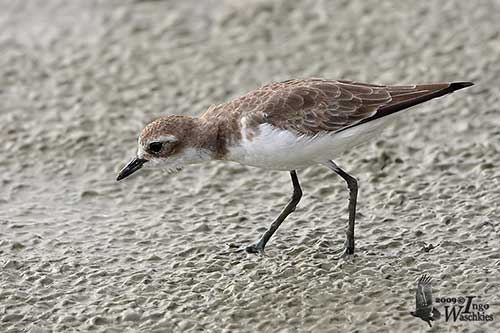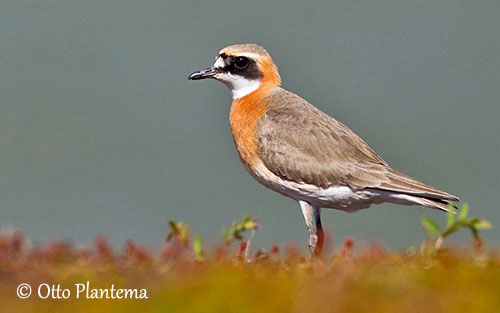
Fr: Gravelot mongol - Pluvier de Mongolie
Ang: Lesser Sand-Plover - Mongolian Plover
All: Mongolenregenpfeifer
Esp: Chorlitejo Mongol Chico
Ita: Corriere mongolo
Nd: Mongoolse Plevier
Sd: mongolpipare
Photographers:
Otto Plantema
Trips around the world
Ingo Waschkies
Bird Photography
Text by Nicole Bouglouan
Sources:
HANDBOOK OF THE BIRDS OF THE WORLD Vol 3 by Josep del Hoyo-Andrew Elliott-Jordi Sargatal - Lynx Edicions - ISBN: 8487334202
SHOREBIRDS by Peter Hayman, John Marchant and Tony Prater – Christopher Helm – 1986 – ISBN: 0747014035
GUIDE DES LIMICOLES de D. Taylor - Delachaux et Niestlé - ISBN : 2603014080
Department of Agriculture, Water and the Environment
Threatened Species of the Northern Territory
SORA - First record of Lesser Sand-Plover (Charadrius mongolus) in Florida
What Bird-The ultimate Bird Guide (Mitchell Waite)
Wikipedia, the free encyclopaedia
Lesser Sand-Plover or Mongolian Plover
Charadrius mongolus
Charadriiformes Order – Charadriidae Family
INTRODUCTION:
The Lesser Sand-Plover or Mongolian Plover breeds at high elevation in the Himalayas, and across the coastal plains of NE Siberia. It also breeds in small numbers in W Alaska. This species is strongly migratory and moves southwards to spend the winter in E Africa, S Asia and Australasia. Five subspecies share this large range.
During the breeding season, it occurs above or beyond the treeline, up to 5,500 metres of elevation. During winter, the species is strictly coastal and frequents sandy beaches and estuaries. It feeds on a variety of aquatic invertebrates, but insects are the main part of the diet during the nesting period. The nest is a scrape in the ground in bare sand or shingle, sometimes protected by stones or vegetation.
The Lesser Sand-Plover or Mongolian Plover is threatened by degradation and loss of the habitat caused by agriculture expansion and tourism disturbance. But currently, the species is not globally endangered.
DESCRIPTION OF THE BIRD:
Biometrics:
Length: 18-21 cm
Wingspan: 45-58 cm
Weight: 39-110 g
The Lesser Sand-Plover or Mongolian Plover male in breeding plumage has greyish-brown upperparts and upperwing-coverts. Sides of rump are white. The tail is grey-brown with narrow, pale terminal band.
On the underparts, chin and throat are white and contrast with the broad, chestnut breastband and neck sides. The breastband is narrowly outlined by black above. The chestnut colour extends onto anterior flanks and upper belly. Rest of underparts is white, including underwing-coverts and axillaries.

On the head, the crown is pale brownish-chestnut. We can see a black or brownish mask extending across forehead, lores and ear-coverts. The forehead may vary between all-black and mainly white with central black line. A paler brownish-chestnut bar on forecrown extends to form a pale supercilium, whitest behind the eye. Nape and hindneck are pale chestnut.
The fairly stout bill is black. The eyes are dark brown. Legs and feet are dark grey, sometimes with greenish tinge.
In breeding plumage, the female has less coloured plumage than male. The black parts are replaced by brown or rufous, but the eye is sometimes surrounded by darker area.
The non-breeding male loses all black and chestnut. The forehead becomes whitish and there is a narrow, white supercilium. Lores, crown, hindneck and upperparts are grey-brown. The whitish fringes of the wing-coverts form a paler area.
The underparts are white with brownish-grey patches on the breats sides, sometimes joining in the centre.
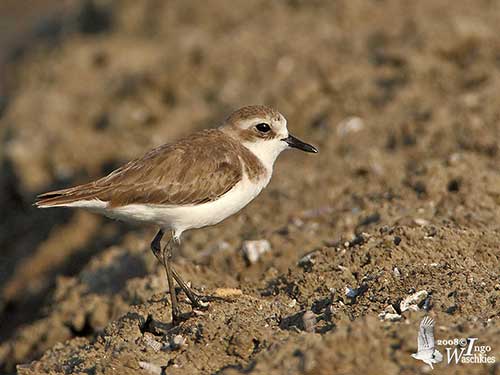
The juvenile resembles adult in winter, with extensively fringed sandy-buff upperparts and upperwing-coverts, brighter on scapulars and tertials. The breast patches are buffish (not chestnut) with grey feather centres.
SUBSPECIES AND RANGE:
The Lesser Sand-Plover or Mongolian Plover has five subspecies.
C.m. pamirensis breeds in Pamirs to W China. It winters in S and E Africa to W India.
This race has short, narrow bill. It may show more white in forehead and white spots in front of the eye. The breastband is paler and narrower.
C.m. atrifons breeds in the Himalayas and S Tibet. It winters from India to Sumatra.
This one has more extensive and better-defined orange breastband. It has white on forehead.
C.m. schaeferi breeds in E Tibet to S Mongolia. It winters in Thailand to Greater Sundas.
This race resembles both previous but the breastband is paler orange and narrower. The bill is slightly longer, and there is no black at breastband upper border.
C.m. mongolus (described above) breeds in E Siberia and Russian Far East. It winters in Taiwan and Australia.
C.m. stegmanni breeds in Kamchatka to Chukotsk Peninsula. It winters in Australia.
This one has more extensive white forehead often divided by a black line. The breastband is dark rufous with narrower black line above.
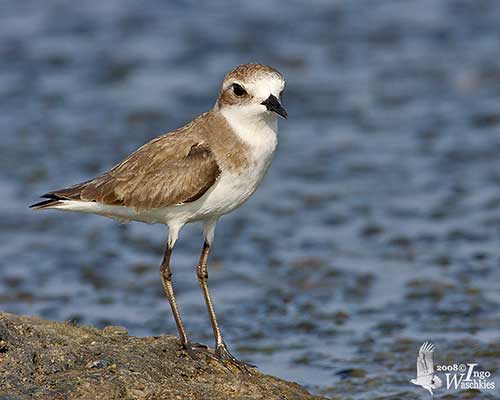
HABITAT:
The Lesser Sand-Plover or Mongolian Plover breeds above or beyond the treeline. It can be seen up to 5,500 metres of elevation in the Himalayas, whereas in Siberia and Commander Islands, it occurs mainly on coastal shingle or sand dunes. It also frequents tundra and mountain steppes, often near water, also rocky, sandy or sparsely vegetated grounds and dry edges of saltmarshes.
On migration, it may occur at inland wetlands or cultivated areas.
During winter, it is strictly coastal and frequents coasts, sandy beaches and estuaries, especially around the Indian Ocean and SW Pacific. In some parts of the range, mangroves are used as roosting sites and feeding areas.
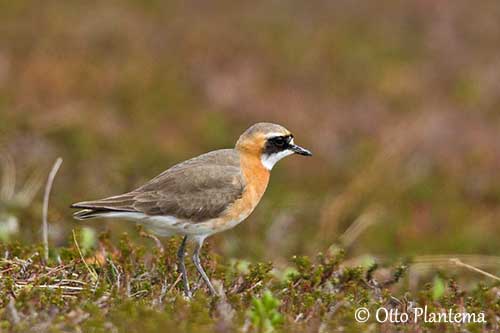
CALLS AND SONGS: SOUNDS BY XENO-CANTO
The Lesser Sand-Plover or Mongolian Plover’s most frequent call is a short, hard “drrrit” often likened to the call of the Ruddy Turnstone. This call is sometimes given in rapid series. We can also hear a sharp “chitik” or ‘chiktik”.
The song given on the breeding grounds is a fast, repeated phrase “kra-ra-rreeee… kra-ra-rreeee…” with soft and scratchy first part and a loud, rolling final syllable. It also produces a low, gravelly “krrree rrrr”.
BEHAVIOUR IN THE WILD:
The Lesser Sand-Plover or Mongolian Plover feeds mainly on beetles and fly larvae on the breeding grounds. Outside this period, it feeds on insects, crustaceans (crabs and amphipods), molluscs, especially bivalves, and worms (Annelids).
It swallows whole the limbless bodies of crabs. The worms are removed from their holes with the bill. It also forages by wading up to breast in the water, and in mudflats, the bird inserts the entire bill into the mud.
The prey are typically caught by a run-and-pause technique. However, it differs from other plovers in running over longer distances and more frequently, and pausing for shorter periods. It may sometimes forage at night. It feeds alone or in mixed-species flocks.
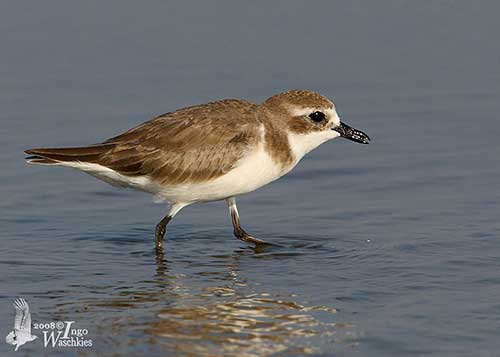
The behaviour of this species during the breeding season is poorly known, but we can suggest that the bright chestnut parts of male’s plumage are displayed during the courtship displays, accompanied by the grating display song “trit-it-it-it” lasting one second. It nests on the ground like numerous Charadriidae species.
The Lesser Sand-Plover or Mongolian Plover is migratory. It breeds in the Northern Hemisphere and moves south to spend the winter in warmer regions.
The flight is swift and direct with rapid wingbeats.
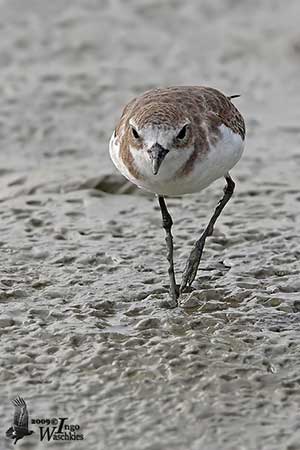
REPRODUCTION OF THIS SPECIES:
The laying usually occurs from late May to mid-June (from mid-May in “pamirensis”).
The nest is a scrape or a shallow depression on bare sand or in shingle, sometimes protected by stone or bushes. Some debris and small stones accumulate inside the nest through the incubation.
The female lays 2-3 reddish-buff to olive-buff eggs with dark spots. She incubates during three weeks. At hatching, the chicks are grey-buff above and whitish below, with black mottling on crown and grey-buff collar on hindneck. They fledge 30-35 days after hatching. They are tended mainly by the male, but sometimes, by both parents.
This species produces a single brood per season, but the female may lay replacements clutches. The main nest predators are foxes.
PROTECTION / THREATS / STATUS:
The Lesser Sand-Plover or Mongolian Plover is affected by degradation and loss of the habitat, caused by development of agriculture, hydrological changes to estuaries and disturbances from tourism.
The global population was estimated to number 310,000/390,000 individuals in 2006.
However, the Lesser Sand-Plover or Mongolian Plover is not considered globally threatened, and the species is currently evaluated as Least Concern.
